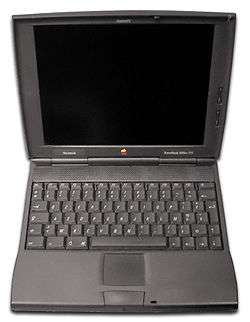PowerBook 1400
|
A PowerBook 1400cs/133. | |
| Developer | Apple Computer |
|---|---|
| Type | Laptop |
| Release date | October 1, 1996 |
| Introductory price | $2499 |
| Discontinued | May 1998 |
| Operating system | Mac OS 7.5.3 |
| CPU | PowerPC 603e (117, 133 or 166 MHz) |
| Memory | 12 or 16 MB integrated |
The PowerBook 1400 was a notebook computer designed and sold by Apple Computer (now Apple Inc.) from 1996 to 1998 as part of their PowerBook series of Macintosh computers. Introduced in November 1996 at a starting price of $2499, it was the first new PowerBook after the controversial PowerBook 5300. After the introduction of the more powerful PowerBook 3400 in February 1997, the 1400 took on the role of Apple's entry level notebook and remained there until its discontinuation in May 1998. Its successor, the PowerBook G3 Series (i.e. - "Wallstreet"/"Mainstreet") would ultimately go on to replace and consolidate not only the 1400, but the 2400 and 3400 as well.
Throughout its 18 months on the market, the PowerBook 1400 was available in a number of different configurations. It was originally released with a 117 MHz PowerPC 603e processor; a 133 MHz processor was added in July 1997, and the line topped out with a 166 MHz processor the following December. Each version was available as either a "c" or a "cs" model, differentiated largely by type of LCD technology used. While both models came with 11.3" color displays with 800 x 600 resolution, the pricier 1400c came equipped with an active matrix display and the 1400cs came with a less expensive passive matrix, dual-scan display.
The optional 6x CD-ROM was implemented using a sleep-swappable module system similar to the one pioneered by the PowerBook 5300; other modules included a Zip drive and the standard 1.4 MB floppy (an 8x CD-ROM would eventually become standard on the 133 MHz model). A pioneering feature of the 1400 was the "BookCover" laptop skin which allowed owners the opportunity to give their PowerBook a customized look. Every 1400 shipped with a gray cover, a clear cover, and six inserts; a ClarisWorks template was also included as an "extra" on the system restore CD, from which users could design their own BookCover. The 1400 was easily upgradeable. System memory modules could be "piggy-backed" onto each other (another feature unique to the 1400), allowing the use of additional RAM. The CPU was located on a removable daughter card, which could be replaced with one containing a faster processor, including a number of commercially available cards with PowerPC G3 processors from vendors such as Sonnet Technologies, NewerTech, and Vimage. Aside from its two PC Card slots, the 1400 also included an internal expansion slot. Although few applications were ever developed to utilize it, Apple did release their own branded video card which included an increased amount of VRAM and an external video port. Other devices included a third-party video card, as well as a relatively rare Ethernet networking card.
There are several well-known issues concerning the PowerBook 1400. Like all other PowerBooks prior to the PowerBook G4, the drive controller used in the 1400 is incompatible with ATA-6 hard drives. Compatibility issues could also arise with hard drives larger than 8.2GB, resolvable by partitioning the boot drive to less than 8.2 GB or by using Mac OS 8.6 or later. Additionally, unlike all Apple notebooks to come after it, the 1400 would not boot from a CD by holding down the "C" key while starting the machine; the only workarounds for this were selecting the CD in the Startup Disk control panel before rebooting, or pressing the Command-Opt-Shift-Del keys.
According to Low End Mac the 117 MHz model is a "compromised Mac" due to the lack of a level 2 cache.
Specifications
| Component | Specification[1] |
|---|---|
| Display | 11.3-inch (29 cm) 15-bit dual scan passive matrix backlit LCD display (1400cs), or active-matrix backlit LCD display (1400c). 800 × 600 pixel resolution |
| Storage | 750 MB, 1 GB or 2 GB EIDE internal hard disk drive; internal/removable 6x, 8x or 12x CD-ROM drive |
| Processor | PowerPC 603e (117, 133 or 166 MHz) |
| Bus speed | 33 MHz |
| Random access memory | 12 or 16 MB integrated; expandable to 64 MB by adding one or two memory modules |
| Read-only memory | 4 MB |
| Networking | None as default, Modem & Ethernet available as upgrades |
| Battery | 1.5-4.0 Hours |
| Physical dimensions | 8.5 in D × 11 in W × 1.8 in H (22 × 28 × 4.6 cm) 6.7 lb (3.04 kg) |
| Port connections | 1 × ADB (keyboard, mouse) 1 × mini-DIN-8 RS-422 serial port (printer/modem, AppleTalk) 1 × HDI-30 connector SCSI (ext. hard drive, scanner) 1 × audio out mini-jack socket 1 × audio in mini-jack socket |
| Expansion slots | 2 PC Card slots, 1 RAM slot (piggyback) |
| Audio | 8-bit stereo |
| Gestalt ID | 310 |
| Code name | Epic |
Timeline of portable Macintoshes

References
- ↑ "Technical Information : Specifications for Macintosh PowerBook 1400 series computers" (PDF). Apple Inc. Retrieved June 8, 2008.
- Apple-history.com: 1400 series specs
- Lowendmac.com: 1400 series specs
